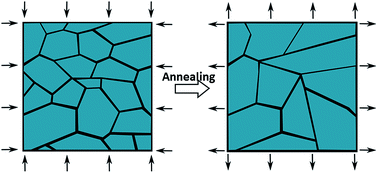Effect of in situ stress on grain growth and texture evolution in sputtered YSZ/Si films†
Abstract
Yttria stabilized zirconia (YSZ) films are being used both as functional oxide and buffer layers for integration of various other functional oxide films on Si substrates. As functional properties of these oxides are highly anisotropic in nature, highly oriented films are essential to realizing their fascinating properties. (111) and (100) textured YSZ films have been deposited on Si substrates by reactive-direct current (R-DC) sputtering. Annealing of these films leads to grain growth and improvement in texture. However, it strongly depends on the growth stresses developed during deposition of these films. Depending on stress harnessing in films/stacks, the texture was improved from rocking curve FWHM of 16° to 7° and 25° to 15° for (111) and (100) YSZ films respectively. A detailed analysis of the relation between stress and grain growth is carried out using an energy balance model. We have found that grain growth is limited by kinetics, though it should be possible from a thermodynamic viewpoint. It is observed that higher initial compressive stress aids significant grain growth (∼150%) and texture-improvement (∼57%) on annealing.



 Please wait while we load your content...
Please wait while we load your content...